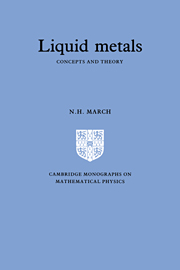Book contents
- Frontmatter
- Contents
- Preface
- 1 Outline
- 2 Pair correlation function and structure factor of ions
- 3 Thermodynamics
- 4 Electron screening and effective ion-ion interactions
- 5 Interionic forces and structural theories
- 6 Statistical mechanics of inhomogeneous systems and freezing theory
- 7 Electronic and atomic transport
- 8 Hydrodynamic limits of correlation functions and neutron scattering
- 9 Critical behaviour
- 10 Electron states, including critical region
- 11 Magnetism of normal and especially of expanded liquid metals
- 12 Liquid-vapour surface
- 13 Binary liquid-metal alloys
- 14 Two-component theory of pure liquid metals
- 15 Shock-wave studies
- 16 Liquid hydrogen plasmas and constitution of Jupiter
- Appendices
- References
- Index
13 - Binary liquid-metal alloys
Published online by Cambridge University Press: 19 January 2010
- Frontmatter
- Contents
- Preface
- 1 Outline
- 2 Pair correlation function and structure factor of ions
- 3 Thermodynamics
- 4 Electron screening and effective ion-ion interactions
- 5 Interionic forces and structural theories
- 6 Statistical mechanics of inhomogeneous systems and freezing theory
- 7 Electronic and atomic transport
- 8 Hydrodynamic limits of correlation functions and neutron scattering
- 9 Critical behaviour
- 10 Electron states, including critical region
- 11 Magnetism of normal and especially of expanded liquid metals
- 12 Liquid-vapour surface
- 13 Binary liquid-metal alloys
- 14 Two-component theory of pure liquid metals
- 15 Shock-wave studies
- 16 Liquid hydrogen plasmas and constitution of Jupiter
- Appendices
- References
- Index
Summary
In the previous chapters, the theory of pure liquid metals has been developed in some depth. The philosophy has been, in essence, to regard a pure liquid metal as a collection of suitably screened ions, interacting via effective ion-ion pair potentials. Recognizing that these pair potentials have features characteristic of liquid metals because the effective ion-ion interactions are mediated by the (almost totally degenerate) assembly of conduction electrons, nevertheless the treatment then is, essentially, that of a onecomponent liquid. In a more basic, fully first-principles treatment of a pure liquid metal, it is really to be viewed as a two-component system: ions, say in liquid Na, Na+, and electrons, e−.
In the present chapter, before turning to this approach to a pure liquid metal, some aspects of the theory of the previous chapters will be generalized to apply to binary liquid-metal alloys, such as Na-K or Na-Cs. Really, such alloys are three-component systems (compare Appendix 14.6), but in this chapter, following the philosophy of the earlier chapters, they will be treated as two-component systems. Thus, in liquid Na-K, the short-range order in the binary liquid metal alloy will be described by three partial pair correlation functions, namely, gNa-Na(r), gk-k(r) and gNa-K(r). The corresponding partial structure factors are SNa-Na(k), and so on. Various linear combinations of these structure factors are often very helpful, as emphasized especially in the work of Bhatia and Thornton (1970).
Of course, such a structural description has to be given for each concentration of the alloy.
- Type
- Chapter
- Information
- Liquid MetalsConcepts and Theory, pp. 202 - 259Publisher: Cambridge University PressPrint publication year: 1990



